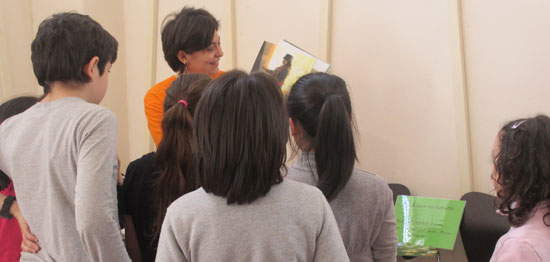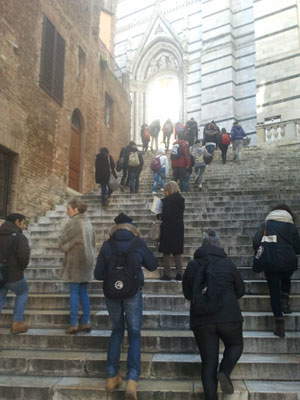One of the greatest challenges for museums nowadays is to attract that part of the public consisting of adolescents. A type of audience with its own characteristics, which needs special attention, special methodologies, targeted educational actions that are both flexible and rigorous. How, then, to engage teenagers in a visit to a museum? We talked about this with an expert: Leontina Sorrentino. With a degree in Conservation of Cultural Heritage from the Suor Orsola Benincasa University in Naples, she then specialized in art education: thus, for the past ten years, her job has been to talk about art to children, teens and adults by working closely with museum realities. On her website, www.didatticaartebambini.it, you can find her methods, the workshops she organizes, with pictures and stories of experiences, and much more. To get in touch with her, you can also visit her Facebook page and Twitter profile. Below is the interview on the topic of adolescents and museums.
The audience of teenagers, roughly corresponding to middle school and high school kids, is one of the most difficult to attract in a museum visit, especially if we think of art museums, where it is not uncommon to see bored teenagers wandering listlessly in front of paintings listening to their music from phones and MP3 players or talking to each other, more or less noisily, about their things, without paying attention to what they are seeing. Why do you think teen audiences are among the least easy to engage in a museum visit?
I don’t think it is more difficult to engage teenagers. Or rather: I find that there are similar difficulties for other target audiences, each one has its own characteristics that need to be evaluated, with great care, when designing paths about art. Pathways that must be rigorous and flexible at the same time. Rigorous on the scientific data and flexible to be adapted to the context in which I am going to operate. This methodology is always valid for everyone from 3 to 90 years old.
If I compare my experiences with groups of adults, adolescents or children, I notice some common traits and substantially similar reactions. I am convinced that boredom or inadequacy is always lurking, just that there are different ways of demonstrating and expressing oneself. Maybe a child reacts by yawning, an adult by nodding mechanically, and a teenager by sticking earbuds in his ears.
The one about adolescents and art remains, however, a very complex and sensitive topic. When I work with them I mainly focus on relationship, choice of topics and seemingly crazy associations.
 |
| Leontina Sorrentino with some young visitors to a museum. |
What are the most macroscopic mistakes made by those who try to bring art to teenagers?
For me, it is necessary to work on two aspects: one of approach and one of content.
One of the mistakes I have seen most often made, which also affected me until I gave it due consideration, is the lack of communicative ’coherence’. We often approach adolescents with a double register: we expect them to have adult reactions, but we treat them as children. I approach them as a friend and then, when the situation gets out of hand, I return normative. This attitude is confusing and predisposes to a ’poorly connected and basically unsatisfactory experience.
The other error is on the choice of content. I find it unattractive for all targets, but especially for that of adolescents, to analyze works only from an iconographic and formal point of view, I consider the artwork as a multimedia page with endless links to click on, not dwelling only on the subject. Having with adolescents an intriguing incipit helps a lot. Asking why the school of color developed precisely in Venice , why the Romanesque was succeeded by the Gothic, what prospectuses were for, trespasses into fields (such as history, geography, technology, costume) that help to better define the artistic one.
In order to better engage adolescents do you think group visits, like those, to be clear, that are done with the school, or less “crowded” and more focused visits?
I believe that group visits have great formative validity.The dialectical confrontation and the personal input of each person serve to grasp the complexity of the messages contained in a work. Conversely, working with large numbers is complex, like “neutralizing” crystallized roles in a class group. For it to be a fully lived experience, it is necessary to have spaces and teaching tools adequate for the number of kids I host. So if only 8 kids out of 30 turn out to be involved one has to question: how much is due to the kids’ lack of interest, and how much to inadequate management of the offer? If, for example, I want to have them paint, I have to have 30 brushes and enough space so that no one is left to watch.
Going to the museum with research groups (a few kids on specific themes) or individually (perhaps with family) is equally important. In this case we have the conditions for a more intimate experience with activation of in-depth strategies. Both need to be cultivated.
Have you experimented with teaching methodologies that stimulate adolescents’ attention and curiosity? If yes, can you describe your methods and what effects have you achieved?
I will start by telling you that there is no magic formula, but continuous research. My method involves some strategies that I have optimized over time and others that I also experiment with improvising, which I then study and analyze through a wealth of documentation.
 |
| A group of teenagers visiting Siena Cathedral. |
In your teaching methodologies, you favor an approach that focuses on people who want to learn and explore art, as in your “Art Conversations.” How important is it for teenagers to feel that they are the protagonists?
What I recommend in my Conversations is to personalize the interventions to make them credible and get them there, consider the context in which we are going to operate, and assess one’s communicative and emotional characteristics to be good mediators. Selecting an artist, genre, movement, century or theme of art is a choice. How to tell about it is also!
More than protagonists (generally few like to show off at that age) I would say they want to feel like individuals. I never fail to approach in a direct and interested way. It is essential to make contact. I do this by valuing the moment of “welcome” , pausing to ask each person’s name, and remembering it during the duration of our meeting, even if it lasts only 1 hour. I have noticed that, this expedient, lowers the level of anxiety and indifference and increases the sense of responsibility. Posing as a listener benefits the relationship and the response. Be precise speaker, but at the same time an attentive interlocutor. Ready to take the stimuli that may arise during a meeting, to turn even a provocation, into a reason for knowledge.
In your opinion, can social networks be useful in enticing teenagers to visit a museum? And if so, how should those who do communication approach teenagers? What channels should they use, what language, what tools...? ?
I have wondered about this many times. As tools, social networks certainly have potential that needs to be exploited. However, without having a ’relational’ basis with the group of adolescents we want to communicate with, I don’t think they work very well. I worked in a Youth Aggregation Center proposing projects on art: against all odds the results were impressive. But it took me 2 years to get in touch, get accepted, become a part of the group. Only then did they let me accompany them on a path that resulted in institutional meetings at the Museum. It is to these kids (aged 12/13) that I owe my first Facebook entry, because they wanted to create a closed group, with the name of the center, which I had to be a part of. I can say that it is thanks to them that I started my journey on the Web. Even today, although the project was cancelled due to lack of funding, I still keep in touch with them through the web.
Some entities, such as the Los Angeles County Museum of Art, are experimenting with “sympathetic” approaches to art, aimed directly at teenagers, by posting on specific social networks (such as Snapchat, used mostly by a teenage audience) images of “repurposed” artworks making witty jokes or humming pop hits loved by teenagers. In your opinion, do such operations make sense, or do they risk trivializing art and, at the same time, undercutting the interests of teenagers?
They are useful and some gimmicks amuse me a lot, too. I think they are a good ’ram’s head’ to break the ice, ironize and try to demythologize the stern aura that has always been created and nurtured around Art . Of course, one cannot stop there. While it is true that there is no single way to talk about art (I can start from hip hop culture to talk about the frescoes of early Christian basilicas, without being afraid of committing heresy) it is also true that one does not have to invent anything to make art interesting. It is enough just to tell about a work, an artist, a movement.
What are museums in Italy currently doing to engage teen audiences, and what could they improve?
It seems to me that Italian museums are investing a lot in education. The multiplication of initiatives, attention to contexts, and a national debate on some social channels, which is interesting and stimulating, are proof of that. Just this summer I activated a #DABinvisita project with the goal of traveling all over Italy to experience, together with my family, the proposals of the Museums. What I see so far, as a professional and as a user, is that we need to work on direct communication (timing, dissemination, clarity of sites, releases, events) and on the creation of a network of educational offerings: combined, interregional, thematic proposals. There are Museums that do not communicate and support each other, despite being part of the same foundation.
Warning: the translation into English of the original Italian article was created using automatic tools. We undertake to review all articles, but we do not guarantee the total absence of inaccuracies in the translation due to the program. You can find the original by clicking on the ITA button. If you find any mistake,please contact us.